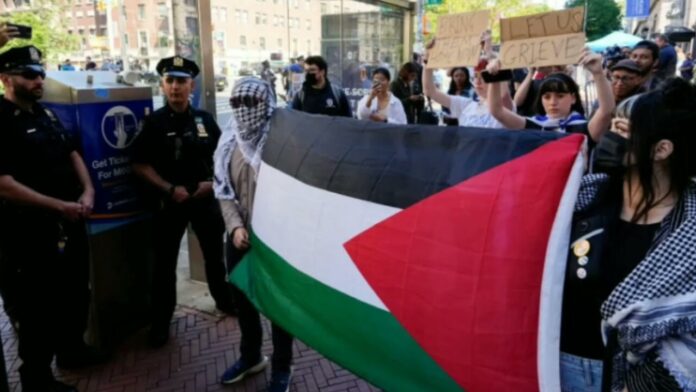The first day of classes at Columbia University saw a resurgence of pro-Palestinian protests amid increased security, reflecting ongoing campus tensions from last year’s demonstrations
Columbia University’s academic year began under the shadow of protests and heightened security, as the campus witnessed a fresh wave of demonstrations on the first day of the semester. The university, known for its vibrant student activism, saw pro-Palestinian protesters gather outside its iconic iron gates, echoing the intense and often contentious demonstrations of the previous year.
The protests, characterized by chanting and drumming, quickly drew attention as students and staff navigated through heightened security measures. The demonstrators, many draped in traditional keffiyeh scarves, rallied with slogans like “Free Palestine,” a reminder of their ongoing support for the Palestinian cause. Their presence was notable several blocks from the university, amplifying their message through rhythmic chants and banners.
Amid the protests, the Alma Mater statue outside Low Memorial Library became a focal point of controversy. Protesters allegedly vandalized the statue with red paint, prompting a swift response from campus maintenance teams who worked to clean the statue and restore its appearance. The university’s response to this incident and the broader demonstrations underscored the challenges of managing campus activism in a polarized environment.
Last year’s protests at Columbia had led to significant unrest, including a pro-Palestinian encampment on the campus quad and subsequent police action that resulted in over 100 arrests. The culmination of these events had forced the university to cancel its main graduation ceremony, leaving a lingering sense of unease as students departed for summer break. The resignation of President Minouche Shafik, who permitted the controversial police raid, added to the backdrop of tension.
As students returned, the pro-Palestinian protesters urged their peers to remember the motivations behind their activism. Flyers distributed by the demonstrators called on students to “put aside your excitement for a new school year and remember the Palestinians who died by our very dollars.” Despite these calls for reflection, many students appeared focused on the new academic year and expressed a sense of security and normalcy.
The protest’s counterpoint came from a small group of pro-Israel students. David Lederer, a junior, organized a counter-protest with a fellow student, displaying a banner reading “Get Support for Terrorism Off Our Campus.” The group’s aim was to address concerns about antisemitism and ensure that discussions on campus included condemnation of terrorism. Their efforts highlight the ongoing tension and division among students regarding the Israeli-Palestinian conflict.
Analysis:
Political: The protests at Columbia University underscore the broader political ramifications of international conflicts on American campuses. The heightened security and renewed activism reflect growing political polarization surrounding the Israeli-Palestinian conflict. Universities, often microcosms of broader societal debates, face the challenge of balancing free expression with maintaining a safe and respectful environment. The protests also illustrate the impact of domestic political figures and policies on campus dynamics, influencing both student activism and institutional responses.
Social: The demonstrations reveal deep-seated societal divisions and the role of universities as platforms for political activism. Columbia University’s campus, like many others, serves as a stage for students to express their political beliefs and engage in social justice causes. The intensity of the protests reflects the broader societal debates about the Israeli-Palestinian conflict and the role of international activism in local settings. The varied responses from students and the administration highlight the complexities of addressing contentious issues while fostering a learning environment.
Racial: The protests and counter-protests also intersect with racial and ethnic identities, as the Israeli-Palestinian conflict involves complex narratives of nationalism, identity, and historical grievances. The presence of pro-Palestinian activists wearing keffiyeh scarves symbolizes a connection to Palestinian heritage and solidarity. Conversely, the concerns raised by pro-Israel students about antisemitism reflect the racial and ethnic dimensions of the conflict, illustrating how global issues can manifest in campus discussions about identity and belonging.
Gender: Gender dynamics are less prominently featured in the current protests but remain relevant in the broader context of activism and representation. Women’s roles in organizing and participating in protests often shape the discourse around social justice issues. The use of gendered language in protest slogans and the representation of women in both pro-Palestinian and pro-Israel groups can influence the dynamics of campus activism, although this aspect is less visible in the current demonstrations.
Economic: The financial implications for Columbia University are significant, as the disruptions from protests and the resulting security measures can impact the institution’s reputation and financial stability. The cancellation of graduation ceremonies and the resignation of the president highlight the economic and administrative costs associated with managing campus unrest. Additionally, ongoing tensions may influence donor relations and student enrollment, reflecting the broader economic impact of campus activism.
